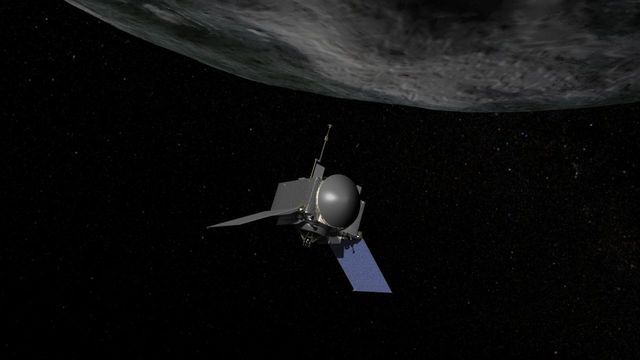NASA to launch asteroid mission Thursday






Asteroids could help scientists learn how life first evolved in space, and NASA is about to rope us a prime candidate for study. On Thursday, an Atlas V rocket set to launch from Cape Canaveral, Florida, will carry the Origins, Spectral Interpretation, Resource Identification and Security-Regolith Explorer (OSIRIS-REx) into space for a rendezvous with an asteroid called Bennu. OSIRIS will return to Earth in 2023 bearing samples of the alien rock.
“The primary objective of the mission is to bring back 60 grams of pristine carbon-rich material from the surface of Bennu,” principal investigator Dante Lauretta of the University of Arizona said in a statement. “We expect these samples will contain organic molecules from the early solar system that may give us information and clues to the origin of life.”
Scientists are interested in these samples for the same reason they like to study comets such as the one orbited by Rosetta and outer solar system objects like Pluto and the dwarf worlds beyond: Planets close to the sun have had enough warmth and energy to change, undergoing geological processes that have turned the basic molecular building blocks of our formative years into new compounds. Rocks flung farther from the sun’s embrace have stayed cold, allowing them to preserve more pristine relics of the solar system’s infancy. The more objects of this nature we study, the more we can infer about the conditions under which our solar system first formed.
By understanding the formation of our own solar system, which for now at least is the only star system where life is known to have evolved, we can better evaluate the potential habitability of other planets and the likelihood of life in general.
“OSIRIS-REx will return the most extraterrestrial material to Earth since the Apollo missions to the moon,” Alessondra Springmann of the University of Arizona told New Scientist magazine.
Scientists will also use the mission to study something called the Yarkovsky effect, which is the slight shift in trajectory that occurs when an asteroid absorbs sunlight and emits the energy as heat. The effect is small, but over time it can significantly alter the course of a big space rock. When calculating the risk of an asteroid colliding with Earth, scientists have to factor in Yarkovsky forces that will affect that asteroid during its journey.
“When that happens, it acts like a thruster and changes the trajectory of the asteroid,” Lauretta told Space.com. “If you want to be able to predict where an object like Bennu is going to be in the future, you have to account for this phenomenon, and we’re going to provide the best-ever scientific investigation of this fascinating concept.”
In fact, the 1,640-foot-wide asteroid Bennu made headlines several weeks ago when scientists made the mistake of admitting it might hit Earth one day, pending Yarkovsky-related trajectory tweaks. Don’t worry too much about that: There’s a 1 in 2,700 chance of Bennu plunging to the Earth 150 years from now. It’s nearly twice as likely that you will die by falling down a flight of stairs than it is that this asteroid will hit us – and the impact wouldn’t destroy the planet anyway.
We won’t really be hitting Bennu, either. OSIRIS will make a maneuver that scientists describe as “a safe, smooth, slow high-five,” barely touching down on the asteroid while using gas to push 60 grams of debris into its clutches. Bennu is thought to be more of a styrofoam-like cluster of rubble than a solid rock, so OSIRIS-REx shouldn’t have too much trouble kicking up enough dust and pebbles to take home.
But we’ve got a long way to go: After launching Thursday, OSIRIS will spend about a year orbiting the sun. When it passes by Earth again, our planet’s gravity will help “slingshot” the spacecraft toward its rocky target. OSIRIS is scheduled to arrive in orbit around Bennu in August 2018. It will use its instruments to create a 3-D map of the asteroid’s surface and select an optimal target for sample retrieval. Its “high-five” is planned for July 2020, and in 2021, when Bennu and Earth are close again, the spacecraft will begin a 2 1/2-year journey back home. The spacecraft itself won’t touch down on our planet, but the samples will eject and land in Utah in 2023.


















